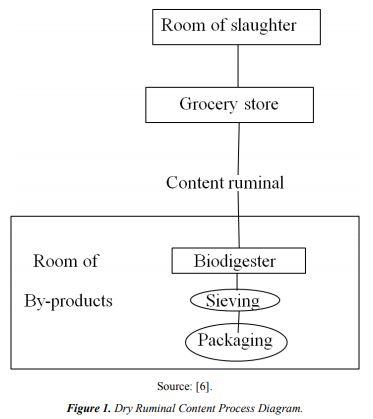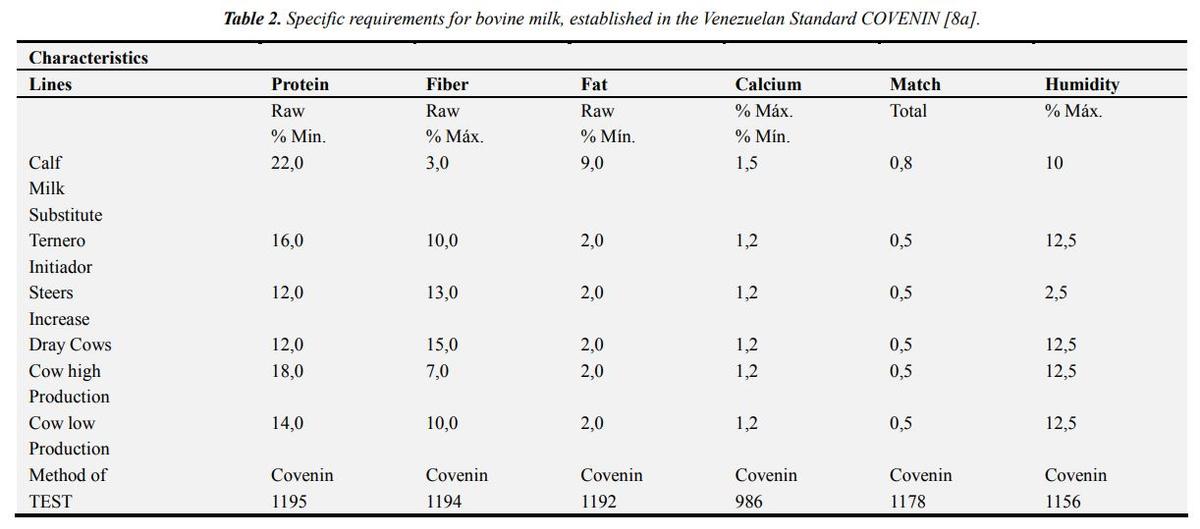1. Introduction
In the agricultural areas of Venezuela, specifically in Píritu municipality, the main problem in animal nutrition is the energy component of balanced rations, due to the inadequacies of this nutrient and the high cost per unit of energy produced locally.
At present, the demand for items used as ingredients for the production of animal feed, such as sorghum is covered up to 60% with imports, as well as 95% soybeans. Because, on the one hand, the domestic production of sorghum supplies only 20% of the demand of the concentrated food industry in Venezuela, and on the other, the production of maize is mainly oriented towards human consumption. Therefore, the concentrated food industry has to import approximately 80% of its requirements in raw material for the elaboration of animal diets for animals.
In the developing countries, in general, many by-products of slaughterhouses or animal slaughterhouses at the rural level are lost and wasted, which may be valuable for animal feed, for lack of knowledge about their use for that purpose. In recent years, the use of ruminal content has been booming in the preparation of different formulations and presentations for animal feed, either by using it directly or by processing it to obtain various commercial products. Within these products [1], can be mentioned, in special form, the Forage Flour (HF) and the nutritional blocks. Not to mention that in some abattoirs, ruminal content is used in vermiculture.
According to results obtained in recent studies and experiences obtained by researchers from other countries, the potential use of ruminal content as an energy source in animal feed contributes with a significant contribution of nutrients, allowing the development of a prospective research for its industrialization.
The continuous price increases in agricultural raw materials and the unavailability of some of these items for the manufacture of concentrated foodstuffs has caused a disproportionate increase, making it difficult to maintain an economically sustainable animal production [2]. In animals, the nutritional aspect is determinant in the productivity, reason why it is important the use of local resources for the reduction of the costs, in the preparation of rations directed to cattle producers of milk and of meat.
It is now uphill to make competition for raw materials that directly contribute to human consumption, so that the use of ruminal content becomes a new unconventional food source for animals [3], [ 4], participating in the reuse of elements in the food chain. On the other hand, the management of the effluent in the rural agroindustry causes problems for the environment due to the organic discharges from the activity of the animal benefit rooms (slaughterhouses), which generate high levels of contamination in the water sources. This situation is particularly difficult in small municipalities, where technical and economic constraints coexist, preventing complex environmental management measures that solve the problem definitively. However, the implementation of preventive measures with simple and inexpensive technological inputs such as the environmentally sound management of organic waste makes it feasible to address the problem efficiently in terms of requirements and results, by requiring few resources and generating added value to the waste management.
These arguments justify the need to generate viable and effective alternatives for integral action, orienting environmental management perspectives that contribute to the improvement of the quality of life of the inhabitants of the agricultural production areas, by reducing the contributing factors of high levels of pollution on the natural resources of which they must enjoy, available and within the reach of the municipal administrations in charge of their implementation.
The main objective of this research is to evaluate ruminal content as an integrated dietary resource for milk and meat animals, analyzing their chemical composition and nutritional value.
1.1. Ruminal Content
Ruminal content is the product obtained from the benefit of cattle in slaughterhouses, represented by the food ingested by the polygastric animals, which is discarded at the time of slaughter. It is a mixture of undigested material that has the consistency of a papilla, of greenish yellow color, characteristic smell very intense when it is fresh, also possesses great amount of microbial flora and fauna as well as products of the ruminal fermentation.
The content of bovine rumen is one of the byproducts that can be used as an ingredient in the rations of the same, which is discarded at present. It is important to note that even at 24 hours of fasting cattle, at the time of slaughter, at least 30 kg of ruminal content can be obtained, since the passage of food through the gastrointestinal tract of ruminants is slow, representing several tons of the product that must be removed. There is a very large variety in slaughterhouse byproducts in terms of quality and quantity; since these depend on the type of feed that the cattle receive [5], in turn also be found differences between regions and countries.
1.2. Ruminal Content Processing
Ruminal content is generated in large quantities in slaughter centers and due to its physical and chemical characteristics, it is one of the major sources of environmental contamination, depending on its final disposal or discharge; As well as being an important food alternative for animals (Table 1). At present, Colombia [6], [7] has important experiences in the implementation of processes for the use of ruminal content in animal feed, an industrial one for obtaining a final product called Fodder Flour (HF) and a semi-industrial for the manufacture of so-called nutritional blocks.
1.3. Production Indices
The yield of ruminal content, when subjected to physical drying processes, reaches 10%. The average production per animal slaughtered is 25 kg. The dry ruminal content in the digester, generically denominated as forage flour with monetary value for sale per kilogram of product, its participation as an ingredient of food rations meets specific requirements according to the growth phase or lines of ruminants; as set out in the Venezuelan Standard COVENIN.
2. Methodology
2.1. Taking of Sample
For the execution of this study, random samples of the Ruminal Content of cattle benefited in the municipal room of slaughter (slaughterhouse) of Píritu, Falcon state in Venezuela, were carried out for five (5) months. The samples were taken directly from the slaughter line when the rumen was opened, thus avoiding contamination with other byproducts and immediately transferred to the processing area at the Animal Nutrition Laboratory of the National Experimental University "Francisco de Miranda". CoroFalcón, Venezuela.
2.2. Obtaining Ruminal Content Flour
The ruminal content can be processed in the area of byproducts (Figure 1), generally an environment in industrial refrigerators that have all the links of the productive chain for the benefit of animals, with the difference that in the production of non- No other by-product of the cattle slaughter is added. The product obtained is used in the balanced feed industry to be included in the formulation of some diets not only for cattle but also for other animal species.
In a schematic way using photographs, the ruminal flour processing demonstrated in Figure 2. Drying: Before conditioning the ruminal content, this stage consisted in removing moisture to the raw material, placing the ruminal content in trays with one kilogram for 48 hours in a stove brand MEMMERT at 65°C; Pilot scale extrapolable to other drying conditions if we use forced air. Grinding: It was performed in a knife mill brand DietzMotoring GMBH Co. Kg.
Sieving: This step consisted in passing through the 150 micron sieve, the flour obtained in the grinding stage, in order to obtain diameters of smaller flour particles. Packaging: The flour was placed in hermetic bags in order to conserve its properties.
After obtaining the ruminal content flour, it was evaluated its Physical-chemical characteristics for the following parameters:
(1). Ash determination (AOAC Method 31012) [9]
(2). Moisture determination (Method AOAC 14004) [9]
(3). Determination of Crude Fiber (Method FIBERTEC 1023) [9]
(4). Determination of total Nitrogen in foodstuffs (Proteins Method Micro Kjeldahl) COVENIN, [10].
2.3. Requirements for Formulating Rations
In the formulation of food rations for cattle in different growing states, there are official requirements established by regulations that help in the preparation of the appropriate rations, as stated in the tables 2, 3 and 4.
3. Results
The characterization of the ruminal meal flour of bovines benefited in the Municipal Room of slaughter of Píritu, Falcon State, Venezuela during five months of the year 2014 is presented in Table 5.
4. Discussion
The ash content, which is the amount of solid material remaining after the sample is incinerated and reflecting the mineral content; In the ruminal meal of samples from the municipality of Píritu state Falcón, Venezuela, the ash content on average was 17.11% (Table 2), when compared to the requirements of animals producing milk and meat established in the COVENIN [8a], [8b] exceed the acceptable range for this parameter in animal requirements, making it a potential ingredient when mineral content is treated.
The results obtained in this study regarding the moisture parameter were discussed with what was reported by [5], [ 6] in their research work on slaughter waste as an animal feed in Santafé de Bogotá, Colombia and the humidity in the rumen flour of the (Table 2), located within the acceptable humidity range, including adjusting perfectly when it comes to ingredients that must be controlled in the water requirement available for microbial growth, which are determinants in the useful life of the product or its fermentation mechanisms.
The fiber determination reported an average value of 21.29%, a value that also fits within the acceptable range for the aforementioned regulations.
The amount of ruminal flour protein in this study reported an average value of 6.77%, compared to the norm [8], we located 2.2% below the minimum range that the cited norm that the Set at 9-13%. However, in our initial purpose, it is not the protein that motivated the work. [3], [4], [5] analyzed that there are factors such as rumination and gastric juices that can cause chemical and biochemical changes in ruminal matter proteins.
Finally, we can say that the characterization of this ruminal content flour reported values for ash, moisture and fiber similar to those of reference [1], [2], [3], [4], except for the protein value, but also not negligible when Associate with other ingredients as well as with other animal feeding stuffs. On the other hand, it was hoped that this characterization would allow to predict for which animal species could be destined potentially as for example in but in bovine feed specifically for dry cows that require in the formulation of the ration a content of 15% fiber.
5. Conclusions
The content of bovine rumen is one of the by-products that can be used as an ingredient in feed rations for animals where the same bovine is included in its different productive age phases.
Ruminal content is a potential that can be used in animal feed in various forms, either by using it as a flour or fibrous ingredient for the preparation of animal feed supplements, as well as in the manufacture of silage and nutritional blocks.
Among the important parameters of the ruminal content flour were the percentage of fiber, which indicated a relatively high value, this implies animals in paddocks with very fibrous pastures, which reduces the proportion in the formulated feed mixture.
This article was originally published in International Journal of Food Chemistry 2017; 1(1): 19-23. doi: 10.11648/j.ijfc.20170101.14.


















